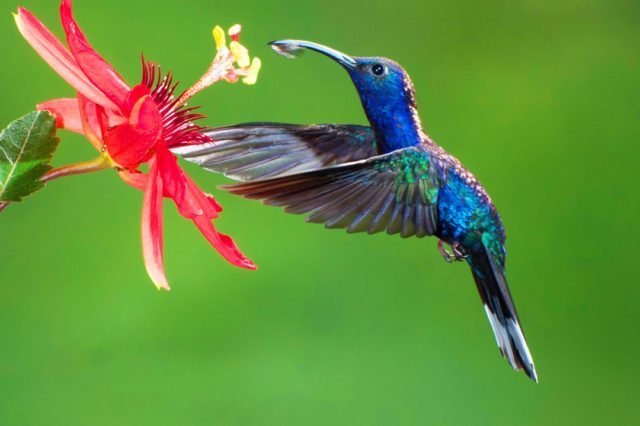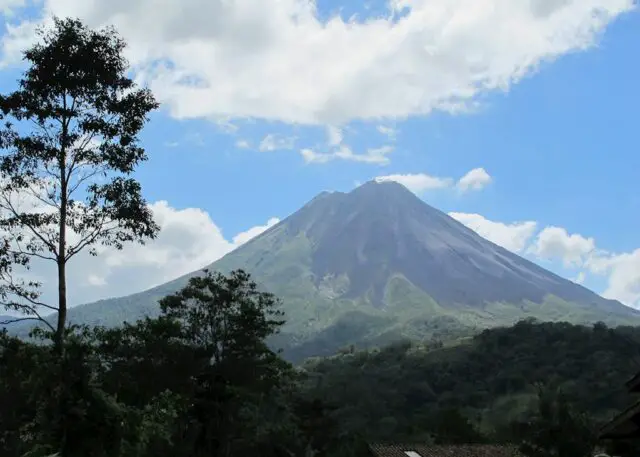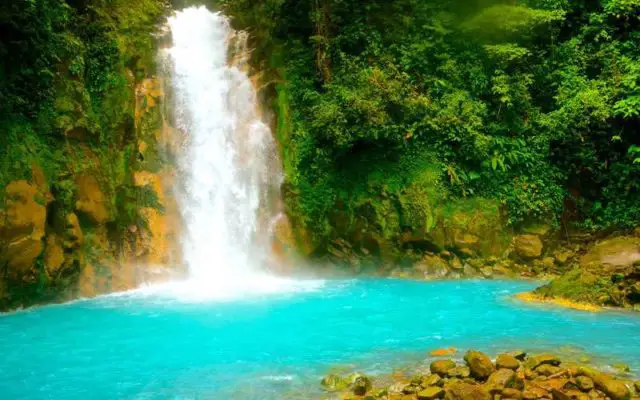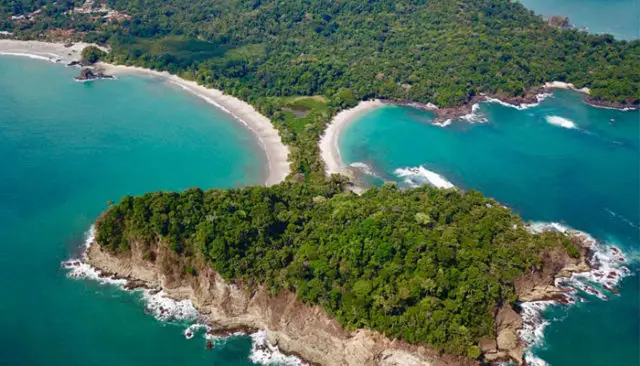Probably the largest number of orchids in Costa Rica grows in Monteverde. And not just from Costa Rica. Monteverde is believed to be home to the largest number of orchid species on the planet, with over 500 different species (there are 34 species endemic to Monteverde and unknown to science). Of all the flora of Monteverde, about 10% are endemisms of the Tilarán mountain range.
Monteverde, with more than 500 species, is the place with the most orchids on the planet. And where these hanging flowers proliferate, there is a group of animals that have adapted to suck their nectar like no other: hummingbirds. Only they with their unbeatable flapping speed are able to suspend themselves in the air to stick their very long tongue in the corolla of the orchid in search of the nectary.
Costa Rica has 50 species of hummingbirds

Costa Rica has no less than 50 species of hummingbirds, undoubtedly another of the main natural attractions for visitors. Until not long ago almost every accommodation in the country had its food dispenser to attract dozens of hummingbirds in its garden. Studies link this easy-to-find food for birds in dispensers with the high concentration of blood sugars in hummingbirds, because they do not consume energy to invest time in their search in the natural environment, have ended this practice that led to fantastic sightings but sick animals. Few places continue to do so. One of them is Café Colibrí, a classic next to the entrance of the Monteverde Reserve.

Observation of sloths in the Arenal Volcano
The sloth is another one of those animals that one hopes to see in Costa Rica. And it is not complicated, but better to focus observation efforts in places where sloth encounters are more frequent. One of the best is the Arenal Volcano National Park. Guarumo trees (Cecropia peltata) abound on the slopes of the volcano, on the perimeter of the park limits and around La Fortuna, whose leaves are the favorite food of sloths. In Costa Rica there are 2 different species of sloths: two-toed sloth (Choloepus hoffmanni) and three-toed sloth (Bradypus tridactylus). In addition to other differences, the most obvious is the different number of fingers on the hands (two or three), since in both species the legs have three toes. Both are eminently arboreal but while the two-toed is nocturnal, the three-toed shows both nocturnal and diurnal behavior.
The margins of the highway between Braulio Carrillo and La Fortuna have areas with a good density of sloths. And although it will not be difficult to observe sloths in freedom (in La Fortuna there are several ecotourism companies that offer walks in search of this folivore), in this town at the foot of the Arenal Volcano there is a private farm that offers guided tours to observe the sloths that live there. But no, don’t look for them on the ground, look in the treetops, they go down exclusively to defecate and this only happens once a week.
Night Walk through the Rain Forest
If the humid tropical forests are the perfect place to practice nature tourism during the day… even better they are at night. When the sun sets, life arises in the jungle, and not at high altitudes, but at ground level. It is the best time of the day to enter the forest – always accompanied by a professional guide – and see how insects, reptiles, arthropods, amphibians take the visual and sound role. One of the things that is most surprising is the sound at night.
Mistico Park is a great option for a night hike through the rainforest. It is located in the Arenal Volcano National Park. Around a couple of hours touring this magnificent representation of the rainforest, full of life, walking with the incentive of hanging bridges, tunnels and nerves on the surface before what we can find. Enjoy the experience in the light of the flashlight …
Bocaracá resting and having a good digestion
Further up the waterfall, and along a muddier path, other sections of the river of special beauty await, such as borbollones, blue lagoon or the teñideros. From the entrance 2.5 kilometers one way to the teñideros. The heat will be a handicap but to see the color in its maximum splendor, we recommend that you take the walk when the sun is at its zenith and as long as it has not rained recently. Find out about the latter at the access door because after heavy rains it will not be possible to enjoy the sky until at least a couple of days later. The walk to the Celeste River is one more incentive, outstanding without a doubt but one more. On the walk to this idyllic corner, do not miss the profusion of tree ferns, orchids and bromeliads that surround the walk along the slopes of the Tenorio Volcano. Home to jaguars, pumas and tapirs. It is one of the most recently created parks (1995) and it is an active volcano, whose sulfur emissions when mixed with calcium carbonate give the river such a unique color.

Rio Celeste Waterfall
A different, unique, almost extraterrestrial proposal, is the visit to the Celeste River. This turquoise river is the greatest natural attraction in the Tenorio Volcano National Park. Legend has it that God, after creating the sky, cleaned his brushes in this river… True or not, what is certain is that it is one of the most outstanding ecotourism experiences in the country. Getting to the viewpoint of the waterfall is simple, just a 40-minute comfortable walk from Puesto Pilón (entrance to the park) through a well-preserved rainforest where it is possible to come across an abundant birdlife, amphibians and reptiles such as ameivas, lizards or snakes. A good number of butterflies will liven up your walk.
Monkeys in the Santa Elena Cloud Forest
Probably the mammals most associated with the image of a forest are primates. And how could it be otherwise in this country, the monkeys will enliven our walk through the heart of the tropical jungle. In Costa Rica there are 4 species of monkeys: howler monkey, spider monkey, white-faced monkey and the marmoset monkey.
The most abundant and widespread throughout the country is the howler monkey (Alouatta palliata). Your observation is almost guaranteed on any walk. Medium in size, it is the largest of the Costa Rican primates and it will surely attract attention for its vocal power, as it emits a guttural sound of enormous power. This loud howl, one of the most powerful of the New World monkeys, is emitted by males in the face of some threat but generally to warn other rival males of their presence. The howl is answered by screams from the females and young of his pack.
The spider monkey (Ateles sp.) Is not as big as the howler. And it is also more discreet. It will not be so frequent to find it, although the Arenal Volcano National Park, the Monteverde Cloud Forest Reserve and the Santa Elena Cloud Forest Reserve, are some of the best enclaves for its observation.
It is a medium-large size jumpsuit but with a very slender and slim figure. Lighter than the howler. It is characterized mainly by its long prehensile tail, which they use as a fifth limb. With a diet that is not so folivorous and somewhat more varied than the howler (leaves, fruits, wood, seeds, etc.), it is the species of monkey in Costa Rica most closely linked to the humid tropical forest.
The white-faced, white-faced or capuchin monkey (Cebus imitator) is a smaller monkey than the previous 2 and is characterized by the white color of the face, neck and the front of the arms. It is omnivorous and a great disperser of pollen and seeds. It is present in a greater number of habitats but the Santa Elena Cloud Forest is a magnificent place to observe it, especially from the spectacular suspension bridges. It is one of the main attractions of Costa Rica and has an important job in the jungle: in addition to being a pollinator and disperser of seeds – whose germination accelerates as they pass through its digestive tract – it feeds on insects that come to plague different tree species.

None of these 3 species are solitary monkeys, so if you are lucky enough to find one on your visit to Santa Elena, take note that there are surely more… The one that you will not see so easy unless you go to certain low forests of the Pacific will be the marmoset monkey (Saimiri oerstedii). The small marmoset or squirrel monkey restricts its presence to the secondary forest of the Pacific coast, at levels below 500 meters of altitude. Rarer than the other 3 species of monkeys in Costa Rica, Manuel Antonio National Park is a good place to observe it.


